Christmas Reminders & Recipes

It’s the most wonderful time of the year! A time for friends, family and some of the feast-worthy meals and treats we wait all year long for. As Christians, we have our eyes fixed on the One who makes this fellowship with all of the cherished folks in our lives possible. We know the true reason for the season is our Father in Heaven. Celebrating the birth of Christ. So where exactly does the food come in?
Food and fellowship have long gone hand in hand. There’s something about an invitation to share a meal with someone that evokes a sense of belonging. Whether you’ve been invited to an annual Christmas gathering with family or friends, or someone has reached out to you to bring you into their circle, there’s a deep parallel to the way Jesus extends an invitation to all of us to belong with Him.
“Also, that everyone should eat and drink and take pleasure in all his toil—this is God’s gift to man.” -Ecclesiastes 3:13
With all this in mind, our 100 Huntley Street team has some delicious recipes and inspiration to share with you! Merry Christmas and God bless!
It just may be the Christmas cooking duo you never knew you needed. Mark Masri and Gregory Thomas Howes teamed up in the kitchen to bring you some festive Christmas cooking ideas. Take a look at this.
Decadent Italian Chocolate Gelato
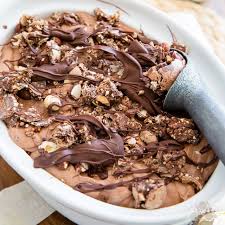
Ingredients
- 1 cup whole milk
- 2 cups heavy cream
- 1 cup unsweetened cocoa
- 1 cup sweetened condensed milk
- 2 tbsp cornstarch
- 2 tsp vanilla extract
- Pinch of salt
- Ferrero Rocher Chocolates
- Plain Unsalted Hazelnuts
- Icing Sugar
Method
- Bring 2 cups of heavy cream to a simmer in a medium saucepan over medium heat, then remove from heat.
- Combine milk, sweetened condensed milk, cornstarch, salt and cocoa in a bowl, whisk, add to hot cream, and cook until cocoa dissolves (5-10 minutes).
- Mix in crumbled Ferrero Rocher.
- Freeze for 5 hours.
- Crumble Ferrero Rocher Chocolates on top of gelato.
- Caramelize unsalted hazelnuts in a skillet with icing sugar.
- Let hazelnuts cool.
- Crush candied hazelnuts and sprinkle on top of gelato.
Watson Family Sugar Cookies
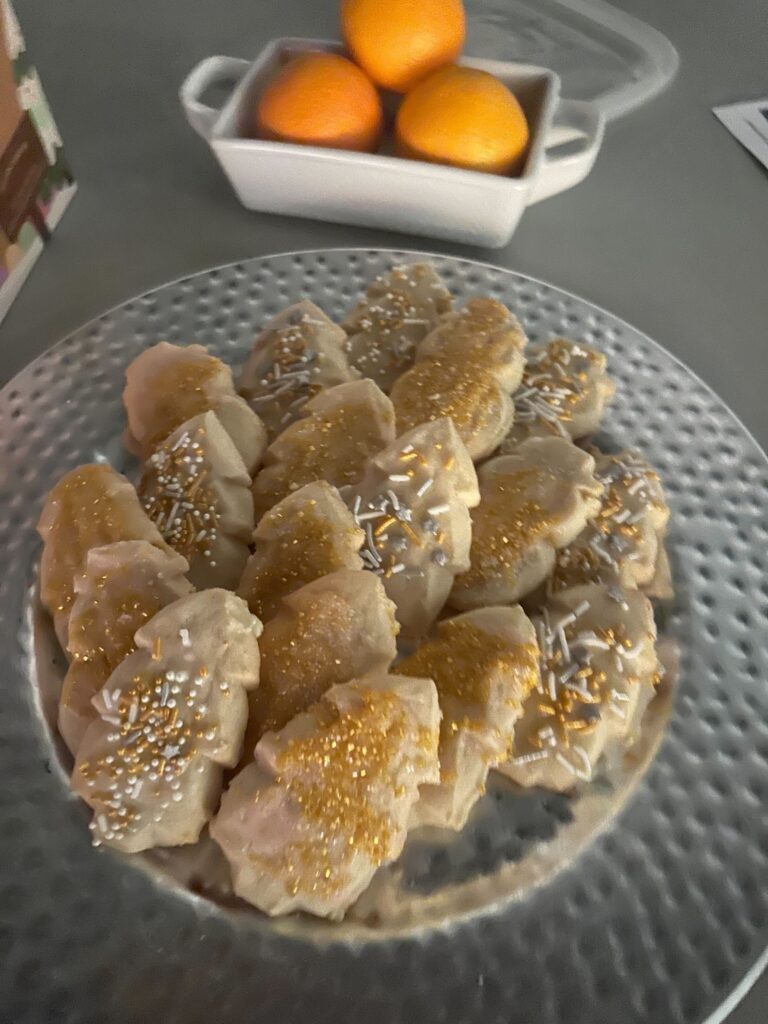
Every year, Jake, Ben, and I turn our kitchen into a holiday workshop, the air filled with the sweet scent of sugar cookies baking. It’s a tradition that has become as much about the process as the finished product. Flour dusts the countertops, and the boys’ hands, coated in icing and sprinkles, create the most delightful chaos. Ben tends to pile on the decorations, while Jake carefully arranges each one like a tiny masterpiece. The laughter and little moments of mischief as we work together make these cookies taste even sweeter. It’s these simple traditions, these shared memories, that make Christmas so special for our family.
Cookies
- 2 ¾ cups all-purpose flour
- 1 teaspoon baking soda
- ½ teaspoon baking powder
- 1 cup butter, softened
- 1 ½ cups white sugar
- 1 egg
- 1 teaspoon vanilla extract
Gather all ingredients. Preheat the oven to 375 degrees F (190 degrees C). Stir flour, baking soda, and baking powder together in a small bowl. Beat sugar and butter together in a large bowl with an electric mixer until smooth. Beat in egg and vanilla. Gradually blend in flour mixture. Roll dough into flat sheet and cut shapes. Bake in the preheated oven until edges are golden, 8 to 10 minutes. Cool on the baking sheets briefly before removing to a wire rack to cool completely.
Icing
- 300g powdered sugar, sifted
- 45g whole milk, cold from the fridge is fine.
Grandma Weber’s Christmas Dark Cake

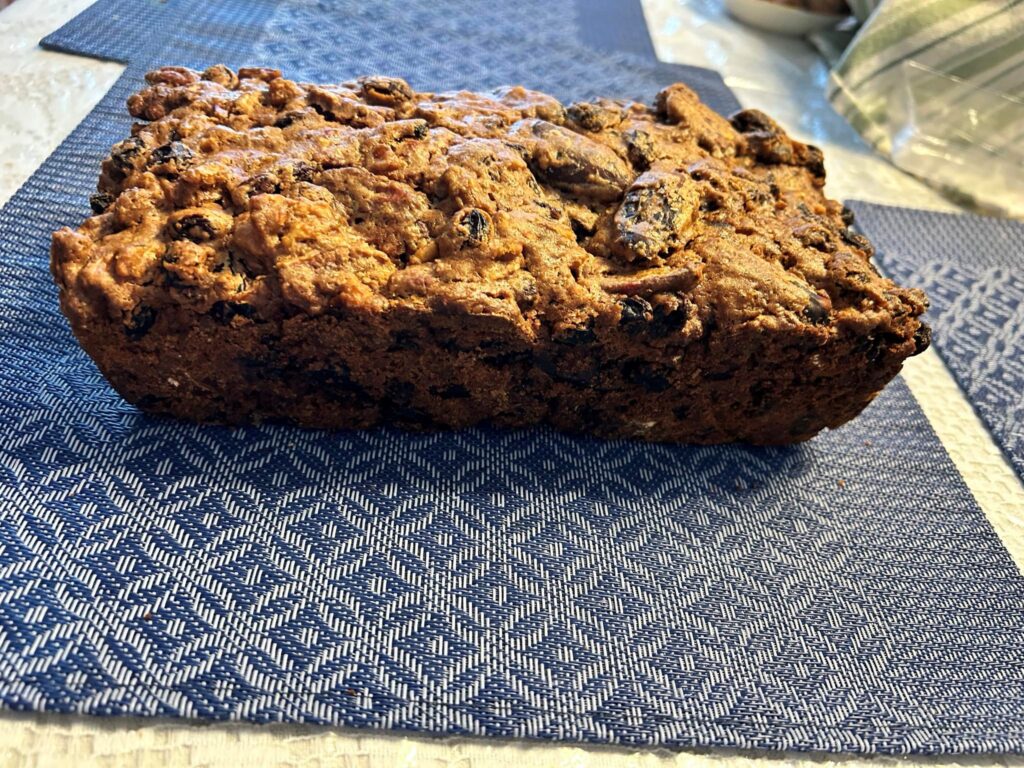
1 lb of butter
5 1/2 cups of flour
3 1/2 cups brown sugar
6 eggs
4 cups of raisins, nuts whole pecans and walnuts
1 1/2 tsp baking Soda
1 tbsp salt
2cups sticky raisins
2tsp mace, 2tsp allspice, 1tsp cloves, 2tsp cinnamon, 1tsp nutmeg
3/4 c. Cherry juice which is dissolved in the Soda
1lb of dates
1 1/2 cups citron peel
Mix butter, sugar and eggs
Mix fruit with 1 cup of flour
Mix in spices
Add to sugar mixture. Mix well
Add rest of flour
Pans 3/4 full
Bake slow at 275 degrees for 3 hours in date and loaf pans
Portuguese Christmas Loaf
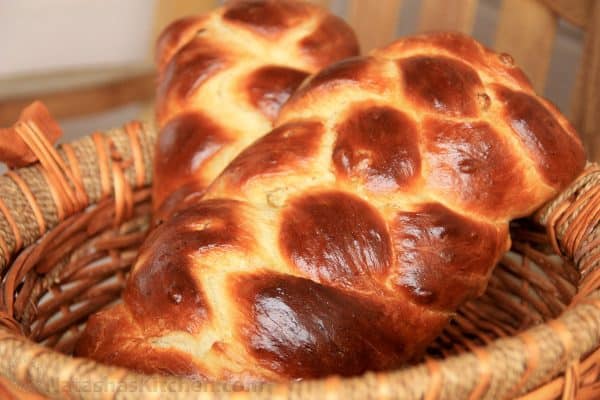
Ingredients
- 1 and 1/2 Cups very warm milk
- 1 cup white sugar + 1 tsp sugar
- 1/2 cup 8 Tbsp unsalted butter, softened
- 1 tsp salt
- 2 envelopes active dry yeast, 1 and 1/2 Tbsp
- 3 eggs, well beaten
- 6 1/2 Cups unsifted all-purpose flour
- 1 egg
- 1 tsp water
- 3/4 cup to 1 cup white or brown raisins + 2 cups boiling water
Instructions
- Place 1 cup white or brown raisins in a bowl with 2 cups boiling water for 10 minutes. Drain well and set the raisins aside.
- Pour 1/2 cup warm milk (heated 30 seconds in microwave) into a large measuring cup. Add 1 tsp sugar and sprinkle yeast over the top. Stir and let it stand to proof until bubbly and doubled in volume, about 10 minutes.
- Combine 1 Cup of very warm milk (1 minute in microwave), with the 1 cup sugar, softened butter and 1 tsp salt in a large bowl. Stir until most of the butter is melted.
- Stir in 3 well-beaten eggs, then yeast mixture into the butter mixture. Using the dough hook attachment (or a wooden spoon if mixing by hand), Beat in 6 1/2 cups flour, one cup at a time until a soft dough forms. Knead for 8-12 minutes or until smooth and elastic. The dough will still be a little sticky and will stick to the bowl but should not stick to your fingers. If kneading by hand, turn out onto a well-floured surface and knead 8-12 minutes (using only enough flour necessary to prevent sticking to your hands).
- Stir in the raisins until evenly distributed.
- Transfer the dough to a large, buttered bowl, turning it to bring the buttered side up. Cover with a tea towel and let rise in a warm place, away from draft, about 1 and 1/2 hours or until double in volume. (Set oven to low, then turn it off and let the dough sit in a warm oven; about 100 degrees F).
- Punch dough down. Turn out onto a lightly floured surface. Divide the dough in half. Divide one half into four equal pieces and form about 15″ strips with each quarter.
- Pinch the four strips together on one end and let the braiding begin!
- Cross the far-right strip over its neighbor.
- Tuck the far-left strip under its neighbor and over the next strip. Repeat steps until you finish the braid, then pinch together the other end.
- Place each braid in a buttered baking dish. Cover loosely with a towel and let them sit for 30 minutes.
- After the braids have been sitting for 30 minutes, pre-heat the oven to 375°F.
- Beat together 1 egg and 1 tsp water. Generously brush the top and sides of the bread with the egg mix just before baking.
- Bake each loaf separately for 20-22 minutes or until golden brown.
Pastéis de Nata ~ Portuguese Custard Tarts
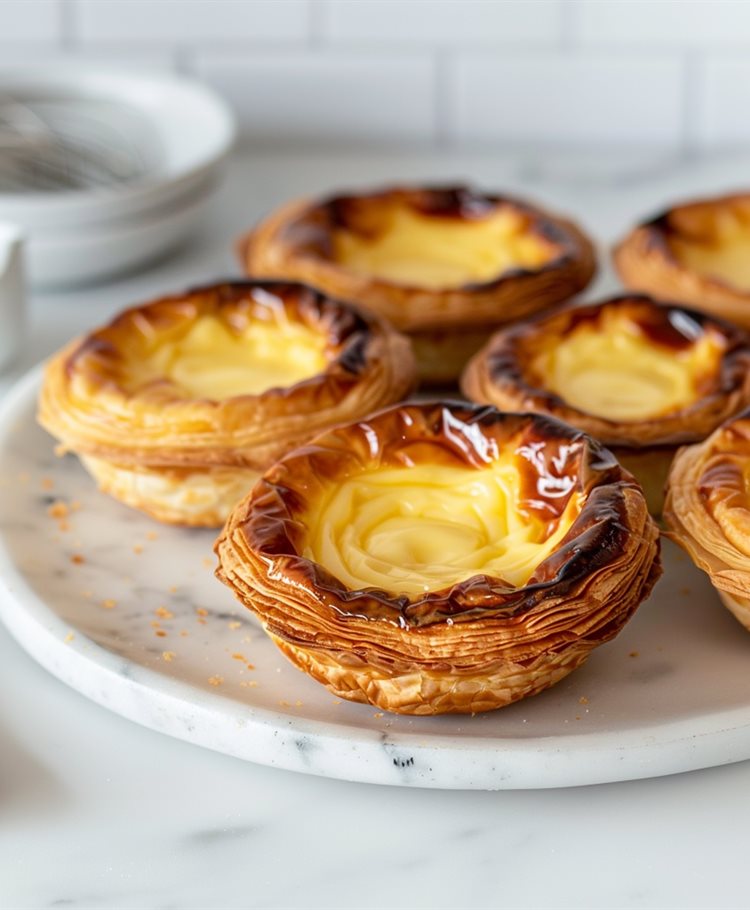
Ingredients
For the pastel de nata dough
- 2 cups minus 2 tablespoons all-purpose flour, plus more for the work surface
- 1/4 teaspoon sea salt
- 3/4 cup plus 2 tablespoons cold water
- 2 sticks (8 oz) unsalted butter, room temperature, stirred until smooth
For the custard
- 3 tablespoons all-purpose flour
- 1 1/4 cups whole milk, divided
- 1 1/3 cups granulated sugar
- 1 cinnamon stick
- 2/3 cup water
- 1/2 teaspoon vanilla extract
- 6 large egg yolks, whisked
For the garnish
- confectioners’ sugar
- ground cinnamon
Instructions
Make the pastel de nata dough
- In a stand mixer fitted with a dough hook, mix the 2 cups minus 2 tablespoons all-purpose flour, 1/4 teaspoon sea salt, and 3/4 cup plus 2 tablespoons cold water until a soft, pillowy dough forms that pulls away from the side of the bowl, about 30 seconds.
- Generously flour a work surface and pat the dough into a 6-inch (15-cm) square using a pastry scraper. Flour the dough, cover with plastic wrap, and let it rest at room temperature for 15 minutes.
- Roll the dough into an 18-inch (46-cm) square. As you work, use the scraper to lift the dough to make sure the underside isn’t sticking to your work surface.
- Brush the excess flour off the top of the dough, trim any uneven edges, and, using a small offset spatula, dot and then spread the left 2/3 portion of the dough with a little less than 1/3 of the 2 sticks (8 oz) unsalted butter being careful to leave a 1 inch (25 mm) plain border around the edge of the dough.
- Neatly fold the unbuttered right 1/3 of the dough (using the pastry scraper to loosen it if it sticks) over the rest of the dough. Brush off any excess flour, then fold over the left 1/3 of the dough. Starting from the top, pat down the dough with your hand to release any air bubbles, and then pinch the edges of the dough to seal. Brush off any excess flour.
- Turn the dough 90° to the left so the fold is facing you. Lift the dough and flour the work surface. Once again roll it out to an 18-inch (46-cm) square, then dot the left 2/3 of the dough with 1/3 of the butter and smear it over the dough. Fold the dough as directed in steps 4 and 5.
- For the last rolling, turn the dough 90° to the left and roll out the dough to an 18-by-21-inch (46-by-53-cm) rectangle, with the shorter side facing you. Spread the remaining butter over the entire surface of the dough.
- Using the spatula as an aid, lift the edge of dough closest to you and roll the dough away from you into a tight log, brushing the excess flour from the underside as you go. Trim the ends and cut the log in half. Wrap each piece in plastic wrap and chill for 2 hours or preferably overnight. (The pastry can be frozen for up to 3 months.)
Make the custard
- In a medium bowl, whisk the 3 tablespoons all-purpose flour and 1/4 cup of the milk (60 ml) until smooth.
- Bring the 1 1/3 cups granulated sugar, 1 cinnamon stick, and 2/3 cup water to a boil in a small saucepan and cook until an instant-read thermometer registers 220°F (104°C). Do not stir.
- Meanwhile, in another small saucepan, scald the remaining 1 cup milk (237 ml). Whisk the hot milk into the flour mixture.
- Remove the cinnamon stick and then pour the sugar syrup in a thin stream into the hot milk-and-flour mixture, whisking briskly. Add the 1/2 teaspoon vanilla extract and stir for a minute until very warm but not hot.
- Whisk in the 6 large egg yolks, strain the mixture into a bowl, cover with plastic wrap, and set aside. The custard will be thin; that is as it should be. (You can refrigerate the custard for up to 3 days.)
Assemble and bake the pastries
- Place an oven rack in the top third position and crank the oven to 550°F (290°C) for at least 30 minutes. The oven needs this time to maintain this blazing hot temperature.
- Remove a pastry log from the refrigerator and roll it back and forth on a lightly floured surface until it’s about an inch (25 mm) in diameter and 16 inches (41 cm) long. Cut it into scant 3/4-inch (18-mm) pieces. Place 1 piece pastry dough, cut side down, in each well of a nonstick 12-cup mini-muffin pan (2-by-5/8-inch [50-by-15-mm] size).
TIP: If using classic egg tart tins, cut the dough into generous 1-inch (25-mm) pieces. Allow the dough pieces to soften for several minutes until pliable.
- Have a small cup of water nearby. Dip your thumbs in the water, then straight down into the middle of the dough spiral. Flatten it against the bottom of the cup to a thickness of about 1/16 inch (1.5 mm), then smooth the dough up the sides and create a raised lip about 1/8 inch (3 mm) above the pan. The pastry bottoms should be thinner than the tops.
- Fill each cup 3/4 full of the cool custard. Bake the pastries until the edges of the dough are frilled and brown, about 8 to 9 minutes for the mini-muffin tins, 15 to 17 minutes for the classic tins.
- Remove from the oven and allow the egg tarts to cool a few minutes in the pan, then transfer to a rack and cool until just warm. Sprinkle the pasteis generously with confectioners’ sugar, then ground cinnamon and serve. Repeat with the remaining pastry and custard. These are best consumed the day they’re made.

